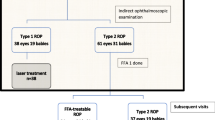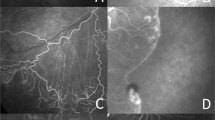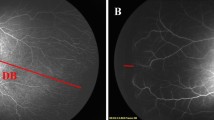Abstract
Purpose
To compare disease regression in cases of Fluorescein Angiography (FA) guided laser vs. conventional laser treatment in infants with Aggressive retinopathy of prematurity (AROP).
Methods
60 eyes of 30 infants of AROP were randomized into two groups. In both the group’s FA was done once. Montage of the fundus, FA images was created and the vascular area, avascular areas, and skip areas after laser treatment were demarcated and measured. In group 1, FA-guided laser treatment was done whereas in group 2 they were lasered without seeing FA. Infants were followed up every week to look for skip areas and disease regression.
Results
The mean vascular retinal area in group 1 and group 2 on fundus images was 302.7 sq. mm and 245.8 sq. mm respectively, while the same on FA was 285.2 sq. mm and 221.3 sq. mm respectively, suggesting overestimation of the vascular area on fundus imaging compared to FA which enabled more objective estimation of avascular loop areas. Retinal skip areas in group 1 and group 2 after 1st laser were 18.7 sq. mm and 73.1 sq. mm respectively (P = 0.001), after 2nd laser was 3.7 sq. mm and 19.2 sq. mm (P = 0.003), which suggests FA-guided laser led to significantly fewer skip areas. Infants had regression in 4.1 ± 0.3 wks and 4.2 ± 0.4 wks in groups 1 and 2, respectively.
Conclusion
FA-guided laser ensured lesser skip areas and more complete laser treatment, though regression was similar in both groups.
This is a preview of subscription content, access via your institution
Access options
Subscribe to this journal
Receive 18 print issues and online access
$259.00 per year
only $14.39 per issue
Buy this article
- Purchase on Springer Link
- Instant access to full article PDF
Prices may be subject to local taxes which are calculated during checkout


Similar content being viewed by others
Data availability
The datasets generated during and/or analysed during the current study are not publicly available due patient privacy but are available from the corresponding author on reasonable request.
References
Chiang MF, Quinn GE, Fielder AR, Ostmo SR, Paul Chan RV, Berrocal A, et al. International classification of retinopathy of prematurity, Third edition. Ophthalmology 2021; S0161-6420:00416–4.
Kumawat D, Sachan A, Shah P, Chawla R, Chandra P. Aggressive posterior retinopathy of prematurity: a review on current understanding. Eye Lond Engl. 2021;35:1140–58.
Shah PK, Narendran V, Kalpana N. Aggressive posterior retinopathy of prematurity in large preterm babies in South India. Arch Dis Child Fetal Neonatal Ed. 2012;97:F371–375.
Stahl A, Lepore D, Fielder A, Fleck B, Reynolds JD, Chiang MF, et al. Ranibizumab versus laser therapy for the treatment of very low birthweight infants with retinopathy of prematurity (RAINBOW): an open-label randomised controlled trial. Lancet. 2019;394:1551–9.
Sankar MJ, Sankar J, Chandra P. Anti-vascular endothelial growth factor (VEGF) drugs for treatment of retinopathy of prematurity. Cochrane Database Syst Rev. 2018;08:CD009734.
Azad R, Chandra P, Khan MA, Darswal A. Role of intravenous fluorescein angiography in early detection and regression of retinopathy of prematurity. J Pediatr Ophthalmol Strabismus. 2008;45:36–9.
Yokoi T, Hiraoka M, Miyamoto M, Yokoi T, Kobayashi Y, Nishina S, et al. Vascular abnormalities in aggressive posterior retinopathy of prematurity detected by fluorescein angiography. Ophthalmology 2009;116:1377–82.
Shah PK, Prabhu V, Ranjan R, Narendran V, Kalpana N. Retinopathy of prematurity: clinical features, classification, natural history, management and outcome. Indian Pediatr. 2016;53:S118–22.
Sanghi G, Dogra MR, Katoch D, Gupta A. Aggressive posterior retinopathy of prematurity in infants ≥1500 g birth weight. Indian J Ophthalmol. 2014;62:254–7.
Sundaram V, Chirla D, Panigrahy N, Kumar P. Current status of NICUs in India: a nationwide survey and the way forward. Indian J Pediatr. 2014;81:1198–204.
Ahn SJ, Kim JH, Kim SJ, Yu YS. Capillary-free vascularized retina in patients with aggressive posterior retinopathy of prematurity and late retinal capillary formation. Korean J Opthalmol. 2013;27:109–15.
Axer-Siegel R, Snir M, Cotlear D, Maayan A, Frilling R, Rosenbaltt I, et al. Diode laser treatment of posterior retinopathy of prematurity. Br J Ophthalmol. 2000;84:1383–6.
Author information
Authors and Affiliations
Contributions
Conception or design of the work; or the acquisition, analysis, or interpretation of data for the work. PK PC. Drafting the work or revising it critically for important intellectual content PK PC RA RC RV. Final approval of the version to be published. PK PC RA RC RV. Agreement to be accountable for all aspects of the work in ensuring that questions related to the accuracy or integrity of any part of the work are appropriately investigated and resolved. PK PC RA RC RV.
Corresponding author
Ethics declarations
Competing interests
The authors declare no competing interests.
Ethics
Institutional ethical committee (AIIMS, New Delhi).
Additional information
Publisher’s note Springer Nature remains neutral with regard to jurisdictional claims in published maps and institutional affiliations.
Rights and permissions
Springer Nature or its licensor (e.g. a society or other partner) holds exclusive rights to this article under a publishing agreement with the author(s) or other rightsholder(s); author self-archiving of the accepted manuscript version of this article is solely governed by the terms of such publishing agreement and applicable law.
About this article
Cite this article
Kumar, P., Chandra, P., Agarwal, R. et al. Role of fluorescein angiography guided laser treatment in aggressive retinopathy of prematurity. Eye 37, 2130–2134 (2023). https://doi.org/10.1038/s41433-022-02302-0
Received:
Revised:
Accepted:
Published:
Issue Date:
DOI: https://doi.org/10.1038/s41433-022-02302-0
This article is cited by
-
Deep learning synthetic angiograms for individuals unable to undergo contrast-guided laser treatment in aggressive retinopathy of prematurity
Eye (2023)
-
Response to: ‘Deep learning synthetic angiograms for individuals unable to undergo contrast-guided laser treatment in aggressive retinopathy of prematurity’
Eye (2023)



